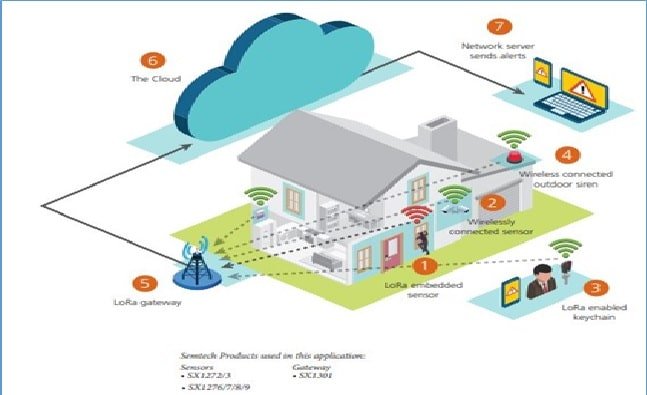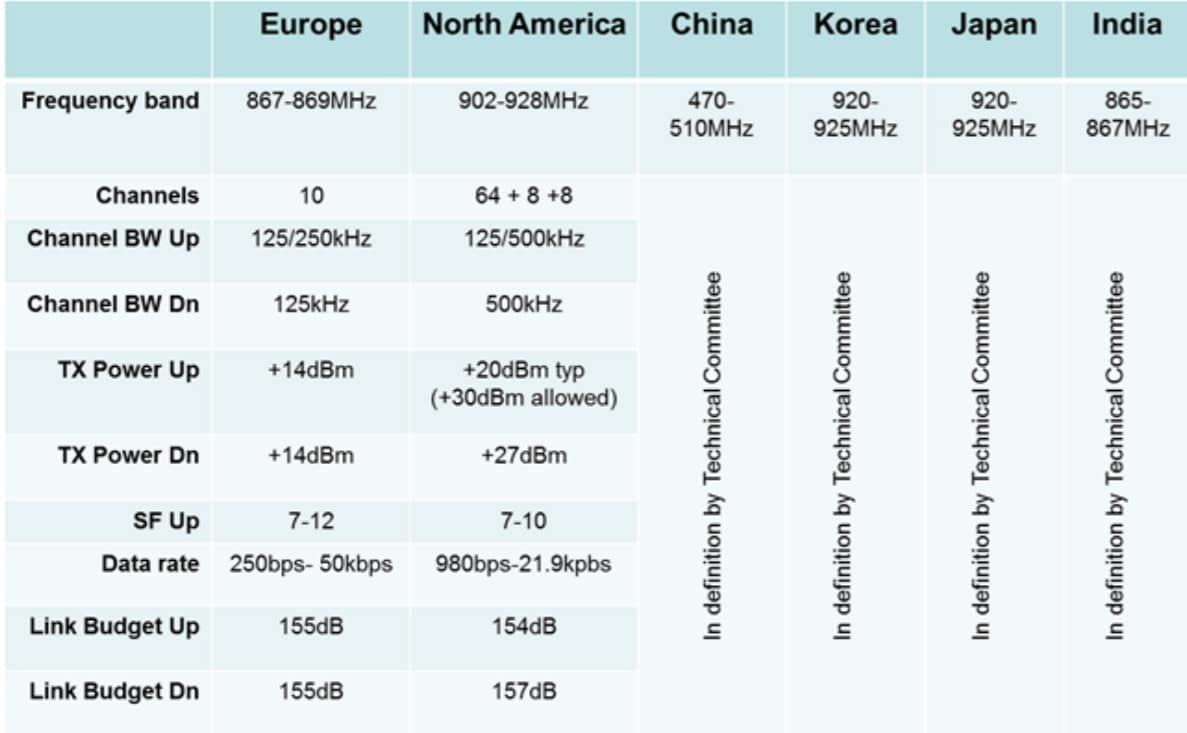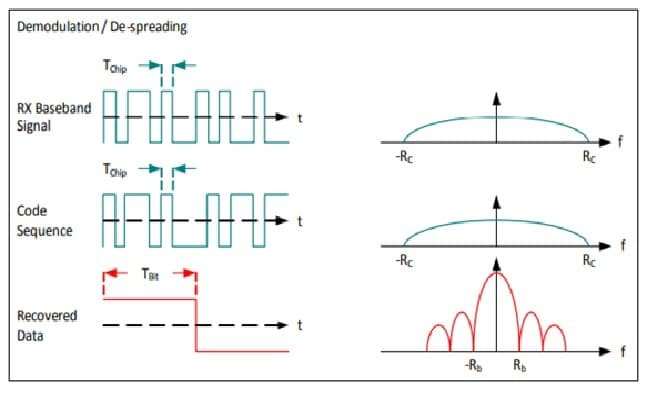Semtech’s LoRa devices and wireless radio frequency technology is a long-range, low power wireless chipset. It is used in a lot of Internet of Things (IoT) networks worldwide, including energy management, natural resource reduction, pollution control, infrastructure efficiency, disaster prevention, etc. LoRa uses license-free sub-gigahertz radio frequency bands to enable efficient long-range transmissions of more than 10 km with extremely high wireless link budgets of around 155 dB to 170 dB. This is higher than any other standardized communication technology. A single gateway or base station can cover a city and entire countries can be covered with minimal infrastructure.
Figure 1: LoRa Smart Home Security System [1]
What is LoRa technology?
LoRa (Long Range) is a spread spectrum modulation technique derived from the chirp spread spectrum (CSS) technology. Chirp Spread Spectrum has been used in military and space communication for decades due to the long communication distances that can be achieved; and robustness to interference.
Direct Spread Spectrum Systems (DSSS) change the carrier phase of the transmitter in accordance with a high frequency code called chip sequence. This code sequence spreads the signal bandwidth of the data signal by an amount referred to as processing gain. The receiver recovers the wanted data signal by re-multiplying with a locally generated replica of the spreading sequence. This compresses the spread signal back to the original bandwidth.
Besides boosting the transmission signal, interfering signals are also reduced by the processing gain of the receiver. They are spread beyond the desired information bandwidth and can be easily removed by filtering. Direct Spread Spectrum Systems require highly accurate reference clock sources for processing long code sequences. As a result, power-constrained devices need to repeatedly and rapidly synchronize.
Compared to Direct Spread Spectrum Systems, Chirp Spread Spectrum Systems have relatively low transmission power requirements. They provide robustness from channel degradation mechanism such as multipath, fading, Doppler and in-band jamming interferers.
LoRa is the first low cost implementation of chirp spread spectrum for commercial use. The spreading of the spectrum is achieved by generating a chirp signal that continuously varies in frequency. The frequency bandwidth of the chirp is equivalent to the spectral bandwidth of the signal. The timing and frequency offset between transmitter and receiver are equivalent, hence the receiver design is greatly simplified. By selecting the spreading factor, LoRa trades off data rate for sensitivity with a fixed channel bandwidth. It uses Forward Error Correction coding to improve resilience against interference. This physical layer maintains the same low power characteristics as Frequency Shift Keying modulation but significantly increases the communication range.
Why LoRa is used?
Hence, it addresses the following issues associated with Direct Spread Spectrum Systems:
- Bandwidth Scalable: LoRa modulation is both bandwidth and frequency scalable. It can be used for both narrowband frequency hopping and wideband sequence applications.
- Constant Envelope / Low-Power: LoRa is a constant envelope modulation scheme. The same low-cost, low-power, high efficiency Power Amplification stages can be re-used without modification. The LoRa processing gain allows the output power of transmitter to be reduced compared to Frequency Shift Keying modulation.
- High Robustness: Due to its asynchronous nature, LoRa signal is very resistant to in-band and out-band interference mechanisms. The LoRa receiver can obtain out-of-channel selectivity figures of 90 dB and co-channel rejection of better than 20 dB.
- Multipath / Fading Resistant: The chirp pulse is relatively broadband and thus LoRa offers immunity to multipath and fading, making it ideal for urban and suburban environments.
- Doppler Resistant: Doppler shift causes a small frequency shift in the LoRa pulse which introduces a relatively negligible shift in the time axis of the baseband signal. The frequency offset tolerance mitigates the requirement for tight tolerance reference clock sources.
- Long Range Capability: For a fixed output power ad throughput, the link budget of LoRa exceeds that of Frequency Shift Keying modulation. The improvement in link budget translates to a great enhancement in range.
- Enhanced Network Capacity: LoRa modulation employs orthogonal spreading factors which enables multiple spread signals to be transmitted at the same time and on the same channel. Modulated signals at different spreading factors appear as noise to the target receiver.
- Ranging / Localization: LoRa can linearly discriminate between frequency and time errors. These devices have geolocation capabilities used for triangulation positions of devices via timestamps from gateways. LoRa is ideal for radar applications and real-time location services.
Figure 2: LoRa Demodulation [2]
Introduction to LoRaWAN
While LoRa physical layer enables the long-range communication link, LoRaWAN (Long Range Wide Area Network) defines the communication protocol and system architecture for the upper layers of the network. The protocol and network architecture dictates the battery lifetime of the node, the network capacity, the quality of service, the security and the variety of applications served by the network. LoRaWAN is maintained by The LoRa Alliance, an open, nonprofit organization having over 500 members. Some members of the LoRa Alliance are IBM, Actility, MicroChip, Orange, Cisco, KPN, Swisscom, Bougues Telecom, Singtel and Proximus. LoRaWAN features in network architecture, device classes, security, scalability for capacity, and optimization for mobility address the widest variety of potential IoT applications.
Figure 3: Comparison of different LPWAN Technologies [3]
LoRaWAN is a cloud-based MAC layer protocol for managing the communication between LPWAN gates and end-node devices as a routing protocol. It manages the communication frequencies, data rates and powers for all devices. Network Devices are asynchronous and transmit when they have data available to send. This type of protocol is referred to as the Aloha method. Unlike synchronous devices, nodes do not have to frequently wake up to synchronize with the network and check for messages. This synchronization consumes significant energy and reduces battery lifetime. Bi-directional end-devices have random receive windows based on their communication needs. Hence, LoRaWAN offers multi-year battery and is designed for sensors and applications that need to send small amounts of data over long distances a few times per hour from varying environments.
LoRaWAN Network layers
The data transmitted by the end-node device is received by multiple gateways, which forward the data packets to a centralized network server. Each gateway will forward the packet via some backhaul, either Cellular, Ethernet, satellite or Wi-Fi. The network server filters duplicate packets, performs security checks, and forward packets to application servers. If a node is mobile, there is no handover needed from gateway to gateway. High network capacity is achieved by utilizing adaptive data rate and by using a multi-channel multi-modem transceiver in the gateway so that simultaneous messages on multiple channels can be received. Since LoRa is spread spectrum based modulation, the signals are practically orthogonal to each other when different spreading factors are used.
The gateway takes advantage of this property to receive multiple different data rates on the same channel at the same time. Adaptive data rate also optimizes battery lifetime. Symmetrical uplink and downlink range improve LoRaWAN scalability 6-8 times compared to other LPWAN alternatives. The technology shows high reliability for the moderate load, however, it has some performance issues related to sending acknowledgments.
LoRaWAN utilizes two layers of security: one for the network and one for the application. AES encryption is used with the key exchange utilizing an IEEE EU164 identifier. Network security ensures the authenticity of the node while the application layer of the security ensures the network operator does not have access to the end user’s application data.
Figure 4: Network Layers for LoRaWAN Application
Different types of LoRa Gateways and Transceivers
A wide variety of standardized LoRa Gateways and Transceivers have been developed. All datasheets, application notes, reference designs, and device-specific tools are available on the Semtech website for software and hardware support.
The SX1308 LoRa Gateway supports the following features:
- Up to -139 dBm sensitivity with SX1257 or SX1255 Tx/Rx front-end
- 70 dB CW interferer rejection at 1 MHz offset
- Able to operate with negative SNR
- CCR up to 9 dB
- Emulates 49x LoRa demodulators and 1x (G) FSK demodulator
- Dual digit Tx and Rx Radio front-end interfaces
- 10 programmable parallel demodulation paths
- Dynamic data-rate adaptation
- True antenna adversity or simultaneous dual-band operation
Figure 5: SX1308 LoRa Gateway Block Diagram
The SX1278 LoRa Transceiver supports the following features:
- LoRa Modem
- 168 dB maximum link budget
- +20 dBm – 100 mW constant RF output vs. V supply
- +14 dBm high efficiency PA
- Programmable bit rate up to 300 kbps
- High sensitivity: down to -148 dBm
- Bullet proof front end: IIP3 = -11 dBm
- Excellent blocking immunity
- Low RX current of 9.9 mA, 200 nA register retention
- Fully integrated synthesizer with a resolution of 61 Hz
- FSK, GFSK, MSK, GMSK, LoRa and OOK modulation
- Built-in bit synchronizer for clock recovery
- Preamble detection
- 127 dB Dynamic Range RSSI
- Automatic RF Sense and CAD with ultra-fast AFC
- Packet engine up to 256 bytes with CRC
- Built—in temperature sensor and low battery indicator
Figure 6: SX1276 LoRa Transceiver Block Diagram
LoRaWAN Regional Summary
The LoRaWAN specifications varies slightly from region to region based on the different regional spectrum allocations and regulatory requirements. The specifications for Europe and North America have been defined, but other regions are still being defined by the LoRa Alliance.
Figure 7: Regional Summary for LoRaWAN
Advantages of LoRa technology
- It can be used to communicate with thousands of IoT nodes and devices.
- It supports long-range communication between 5-15km.
- Power consumption is very low as compared to other IoT protocols. Therefore, it is a best choice for battery critical applications which indeed is a major requirement for all embedded system projects.
- The frequency band used for LoRa is easily available in almost all countries of the world.




